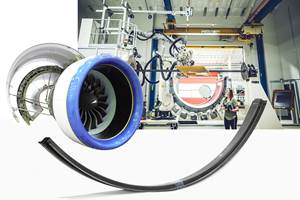Fiber sizing, tow spreading and the quest for encapsulation
Fiber sizing is easily overlooked by composites fabricators, but it will be increasingly important to optimization of fiber performance.
Whenever a composites manufacturer thinks about fabricating a part or structure, he or she, understandably, focuses on the basic, raw ingredients of a composite application: resin, fiber, tooling, processing, finishing. Absent from these considerations most of the time is fiber sizing — the chemistry applied to fibers to facilitate handling, minimize abrasion, promote resin/filament adhesion or convey some other property to the fiber to help optimize mechanical properties in the final part.
Sizing is easily overlooked because it is typically applied by the fiber manufacturer using chemistry that is often tightly controlled. Further, sizing is a material that is most noticeable by the handling, processing and performance headaches that arise in its absence. When it is present, on the other hand, it performs with rare recognition.
As resins and fibers evolve, however, sizing is likely to move closer to the top of the composites industry’s collective mind. Dr. Nagesh Potluri, group technology director at sizing specialist Michelman (Cincinnati, Ohio, U.S.), says the chemical and physical complexities surrounding fiber sizing should not be underestimated.
Michelman’s history is grounded primarily in development and manufacture of sizing for glass fibers reinforcing polypropylene (PP). The company also has sizings optimized for use with polyamide (PA) and polyurethane (PU) polymers. Potluri notes, however, that the company recognizes the aerospace industry’s tilt toward increased use of thermoplastic matrix resins, and sees an opportunity.
Continuous fibers used with aerospace thermoplastics, like PEKK, PAEK and PEEK, typically go unsized, mainly because high temperatures make sizing use challenging. Michelman, however, is working on technologies that will enable thermoplastic sizing.
This work has led to another, related, area of interest: fiber spreading. Potluri notes that carbon fiber tows, whether being used to make unidirectional tapes or woven fabrics, must first be spread to flatten out and straighten the filaments. Generally speaking, carbon fibers of 3-12K tow are relatively easy to spread, while larger tows are more cumbersome and difficult to spread, primarily because of fiber-to-fiber friction, which can cause filament entanglement or breakage. Potluri argues that a well-spread tow facilitates more even sizing distribution, which, in turn, promotes better resin/fiber adhesion.
“The weakest link in a composite is the matrix,” Potluri says. “That’s why we like high fiber volumes. For this reason, you want the matrix to impregnate the interstitial spaces between fibers and maximize the mechanical properties embedded in the fibers. Effective spreading does that.”
In a typical carbon fiber fabric, he says, just 60-70 percent of all filaments interact with, or are encapsulated by, the matrix resin. To increase this number, Michelman is working on a lubricant-based sizing that would be applied to a carbon fiber tow to minimize fiber-to-fiber friction and ease spreading, and by extension improve fiber/matrix distribution. “If we do that,” Potluri says, “we are essentially getting to theoretical maximum fiber performance values.”
The Next Generation of Aerospace Manufacturing
With the commercial aviation industry projected to double in the next 20 years, meeting the demand for passenger and freight aircraft will require new technologies and unprecedented manufacturing rates.
Learn more about the materials and processes that will shape next-generation aircraft in a collection of stories from ÂÌñÏ×ÆÞ, Modern Machine Shop and Additive Manufacturing, available to read or download for free. Get it here.
Related Content
The potential for thermoplastic composite nacelles
Collins Aerospace draws on global team, decades of experience to demonstrate large, curved AFP and welded structures for the next generation of aircraft.
Read MorePlant tour: Collins Aerospace, Riverside, Calif., U.S. and Almere, Netherlands
Composite Tier 1’s long history, acquisition of stamped parts pioneer Dutch Thermoplastic Components, advances roadmap for growth in thermoplastic composite parts.
Read MoreAssembling the Multifunctional Fuselage Demonstrator: The final welds
Building the all-thermoplastic composite fuselage demonstrator comes to an end with continuous ultrasonic welding of the RH longitudinal fuselage joint and resistance welding for coupling of the fuselage frames across the upper and lower halves.
Read MoreThermoplastic composites: Cracking the horizontal body panel nut
Versatile sandwich panel technology solves decades-long exterior automotive challenge.
Read MoreRead Next
Next-gen fan blades: Hybrid twin RTM, printed sensors, laser shock disassembly
MORPHO project demonstrates blade with 20% faster RTM cure cycle, uses AI-based monitoring for improved maintenance/life cycle management and proves laser shock disassembly for recycling.
Read MoreCeramic matrix composites: Faster, cheaper, higher temperature
New players proliferate, increasing CMC materials and manufacturing capacity, novel processes and automation to meet demand for higher part volumes and performance.
Read MoreCutting 100 pounds, certification time for the X-59 nose cone
Swift Engineering used HyperX software to remove 100 pounds from 38-foot graphite/epoxy cored nose cone for X-59 supersonic aircraft.
Read More













